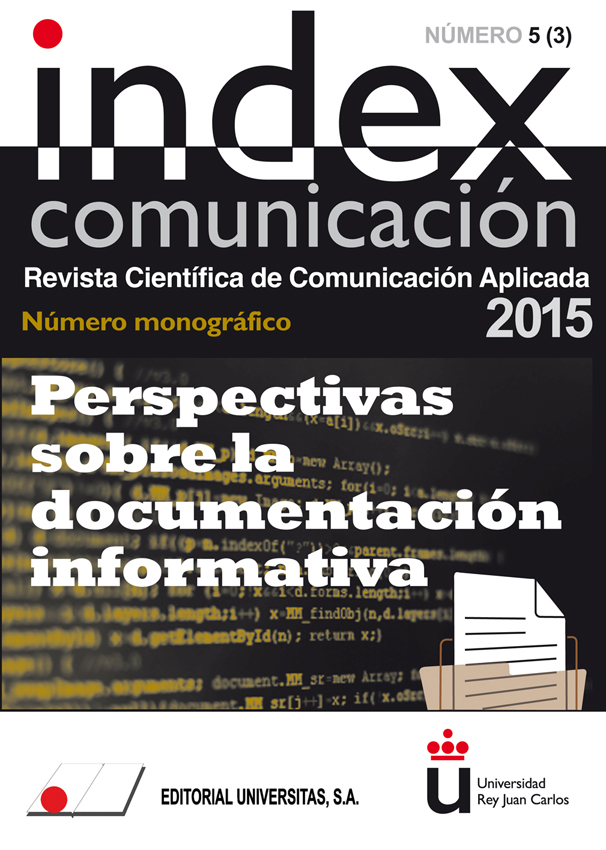Social TV on Fiction Series and New Roles for a Media Librarian: ‘El Ministerio del Tiempo’ as a Case Study
Keywords:
televisión, Twitter, audiencia social, redes sociales, televisión 2.0, participación, archivo, documentación audiovisual, series de ficción, El Ministerio del TiempoAbstract
New and multiple access devices and distribution channels to audiovisual content has led to the emergence of the phenomenon known as ‘second screen’ and the existence of more proactive and participatory consumption of audiovisual products by consumers. We make a bibliographic review on the concepts of social television and audience, transmedia storytelling and the new roles of audiovisual archivists on the generation of added value on audiovisual products, especially in social audiences deferred in time. To this end we have analized the television serie The Ministry of Time, premiered the public Spanish television La 1 - TVE. We collected and analyzed more than 30,000 tweets sent with some of the hashtags used by producers and consumers of the television serie. The results show a high dispersion in the number of authors, a concentration of a few authors that send many tweets and a vast majority who just send one or two tweets but represent over 90% of all the tweets sent. We also conducted an analysis of both, hashtags and content analysis of the messages showing some terms and words that show the degree of consumer satisfaction with the serie and the positive sentiment to some of the characters.Metrics
References
Álvarez, J. (2015): ‘«El Ministerio del tiempo» mejora notablemente su audiencia en diferido’, en Bluper. Recuperado de http://www.bluper.es/noticias/el-ministerio-del-tiempo-mejora-notablemente-audiencia-diferido
Anderson, C. (2006): The Long Tail: Why the Future Is Selling Less of More. Hachette Books.
Anthony, L. (2015): Antconc HomePage. Recuperado de http://www.laurenceanthony.net/software/antconc/
Askwith, I. D. (2007): ‘Television 2.0: reconceptualizing TV as an engagement medium’, (tesis doctoral no publicada). Massachusetts Institute of Technology. Recuperado de http://dspace.mit.edu/handle/1721.1/41243
Awoniyi, B. (2013): ‘Three reasons why Facebook can't beat Twitter for social TV’. Recuperado de https://econsultancy.com/blog/63529-three-reasons-why-facebook-can-t-beat-twitter-for-social-tv
Cortés, I. (2015): ‘El Ministerio del Tiempo en redes sociales’. Recuperado de http://ildecortes.com/2015/05/analizando-el-ministerio-del-tiempo-un-exito-en-redes-y-television/
Deltell Escolar, L. (2014): ‘Audiencia social versus audiencia creativa: caso de estudio Twitter’, en Estudios Sobre El Mensaje Periodístico, nº 20 (1), pp. 33–47. Recuperado de http://doi.org/http://dx.doi.org/10.5209/rev_ESMP.2014.v20.n1.45217
Fernández, J. M. (2015): ‘Revolución en las audiencias: Kantar comienza a medir datos en diferido’, en Bluper. Recuperado de http://www.bluper.es/noticias/revolucion-mercado-audiencias-kantar-media-comienza-medir-audiencia-en-diferido
González Neira, A. y Quintas Froufe, N. (2014): ‘Audiencia tradicional frente a audiencia social: un análisis comparativo en el prime-time televisivo’, en Revista Mediterránea de Comunicación, pp. 105–121. Recuperado de http://doi.org/10.14198/MEDCOM2014.5.1.02
Hawksey, M. (2014). TAGS. Recuperado de https://tags.hawksey.info/
Jenkins, H. (2003): ‘Transmedia storytelling’. Recuperado de http://www.technologyreview.com/news/401760/transmedia-storytelling/
Jenkins, H. (2006): Convergence Culture: Where Old and New Media Collide. NYU Press.
Jenkins, H. (2011): ‘Transmedia 202: Further Reflections’. Recuperado de http://henryjenkins.org/2011/08/defining_transmedia_further_re.html
Kinder, M. (1991): Playing with Power in Movies, Television, and Video Games: From Muppet Babies to Teenage Mutant Ninja Turtles. Berkeley: University of California Press.
Lorente-Cano, M. (2011): ‘«Social TV» en España: concepto, desarrollo e implicaciones’, en Cuadernos de Gestión de Información, 1 (1), pp. 55–64.
O’Reilly, T. (2005): ‘What is Web 2.0. Design Patterns and Bussiness Models for the Next Generation of Software’. Recuperado de: http://www.oreillynet.com/pub/a/oreilly/tim/news/2005/09/30/what-is-web-20.html
Pimentel, A. (2015): ‘Ministéricos: radiografía de un fenómeno fan televisivo en la era de internet y las redes sociales’. Recuperado de http://www.rtve.es/television/20150421/ministericos-radiografia-fenomeno-fan-televisivo-era-internet/1133040.shtml
Sánchez, C. (2015): ‘Kantar - ¿Para qué sirve medir la audiencia social de televisión?’ Recuperado de http://es.kantar.com/media/tv/2015/abril-2015-%C2%BFcu%C3%A1l-es-el-verdadero-sentido-de-medir-la-audiencia-social-de-la-televisi%C3%B3n/
˛ Scolari, C. A. (2009): ‘Transmedia Storytelling: Implicit Consumers, Narrative Worlds, and Branding in Contemporary Media Production’, en International Journal of Communication, nº 3 (0), p. 21.
The Nielsen Company. (2015a): ‘What Moves the Social TV Needle?’ Recuperado de http://bit.ly/1RRc0yO
The Nielsen Company. (2015b): ‘Social TV: A Bellwether for TV Audience Engagement’. Recuperado de http://bit.ly/1AQnkyT
Tur-Viñes, V. y Rodríguez Ferrándiz, R. (2014): ‘Transmedialidad: series de ficción y redes sociales. El caso de Pulseras Rojas en el grupo oficial de Facebook (Antena 3. España)’, en Cuadernos.info, nº 34, pp. 115–131. Recuperado de http://doi.org/10.7764/cdi.34.549
Yang, B. y Zisiadis, M. (2014): ‘Transmedia marketing: strengthening multiplatform user participation through storytelling’. Recuperado de http://www.diva-portal.org/smash/record.jsf?dswid=7795&pid=diva2%3A727294&c=1&searchType=SIMPLE&language=en&query=Binbin+Yang&af=%5B%5D&aq=%5B%5B%5D%5D&aq2=%5B%5B%5D%5D&aqe=%5B%5D&noOfRows=50&sortOrder=author_sort_asc&onlyFullText=false&sf=all&jfwid=7795
Downloads
Published
How to Cite
Issue
Section
License
Authors who submit to this journal agree to the following terms:
Authors retain copyright and ensure the magazine's right to be the first publication of the work as licensed under a Creative Commons Attribution-NoComercial 4.0 International License that allows others to share the work with an acknowledgment of authorship of the work and the initial publication in this magazine, with no commercial purpose.
Authors can establish separate additional agreements for non-exclusive distribution of the version of the work published in the magazine (for example, to an institutional repository or publish it in a book), with an acknowledgment of its initial publication in this journal.
It allows and authors are encouraged to disseminate their work electronically (eg, in institutional repositories or on their own website) prior to and during the submission process, as it can lead to productive exchanges, as well as a citation more early and most of the published work (See The Effect of Open Access).















